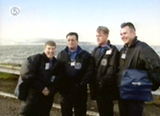 In the late 1980s attention was diverted momentarily to satellite tv in the guise of BSB, though this was ‘merged’ with the News Corp.-owned Sky service in 1990. Initially it was envisaged that the remaining terrestrial allocations would be used for local services, but a change of heart caused by a lack of suitable applicants combined with a desire to generate revenue caused a fifth ‘national’ service to be born. It was essentially a two-horse race, with the winner having to arrange for thousands of video recorders, games consoles, etc. to be adjusted because a common frequency used to distribute video signals (UHF channel 36) was widely used by Channel 5. Retuning delays forced a planned December 1996 launch to be postponed.
In the late 1980s attention was diverted momentarily to satellite tv in the guise of BSB, though this was ‘merged’ with the News Corp.-owned Sky service in 1990. Initially it was envisaged that the remaining terrestrial allocations would be used for local services, but a change of heart caused by a lack of suitable applicants combined with a desire to generate revenue caused a fifth ‘national’ service to be born. It was essentially a two-horse race, with the winner having to arrange for thousands of video recorders, games consoles, etc. to be adjusted because a common frequency used to distribute video signals (UHF channel 36) was widely used by Channel 5. Retuning delays forced a planned December 1996 launch to be postponed.
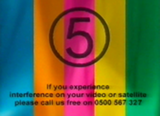 Channel 5 was launched on Saturday March 30 1997 into what was a much more hostile media climate than what existed at the start of the previous four services. As well as the other four terrestrial channels, Channel 5 has to compete against the numerous and growing number of satellite channels, as well as (arguably) ‘new media’ services such as the internet (which was starting to grow rapidly at the time); these rival services also happen to attract mostly the young target audience that the new channel was aiming at. To cap it all, due to the restricted coverage, less than 70% of the country could receive it, and many of those that could had to suffer an inferior picture due to many transmitters operating on a lower power.
Channel 5 was launched on Saturday March 30 1997 into what was a much more hostile media climate than what existed at the start of the previous four services. As well as the other four terrestrial channels, Channel 5 has to compete against the numerous and growing number of satellite channels, as well as (arguably) ‘new media’ services such as the internet (which was starting to grow rapidly at the time); these rival services also happen to attract mostly the young target audience that the new channel was aiming at. To cap it all, due to the restricted coverage, less than 70% of the country could receive it, and many of those that could had to suffer an inferior picture due to many transmitters operating on a lower power.
 Who better to launch a new tv channel wanting to portray a young image than the hottest popular music act of the moment which also happens to have five members as well! Enter the Spice Girls, performing a song based on Manfred Mann’s “5-4-3-2-1” (same tune, different lyrics: retitled “1-2-3-4-5”). Trivia time: Channel 5 is the only terrestrial station never to have had a test card (though before launch it did have a tuning signal caption), and has provided a 24-hour service from day one. It was also the only terrestrial station to feature a permanent on-screen identification ‘bug’ or DOG (digitally originated graphic) at the time, though they subsequently made the symbol less prominent before ditching it altogether with the change from Channel 5 to “Five”, then it appeared again with a later rebrand.
Who better to launch a new tv channel wanting to portray a young image than the hottest popular music act of the moment which also happens to have five members as well! Enter the Spice Girls, performing a song based on Manfred Mann’s “5-4-3-2-1” (same tune, different lyrics: retitled “1-2-3-4-5”). Trivia time: Channel 5 is the only terrestrial station never to have had a test card (though before launch it did have a tuning signal caption), and has provided a 24-hour service from day one. It was also the only terrestrial station to feature a permanent on-screen identification ‘bug’ or DOG (digitally originated graphic) at the time, though they subsequently made the symbol less prominent before ditching it altogether with the change from Channel 5 to “Five”, then it appeared again with a later rebrand.
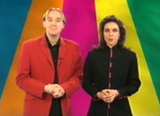 Tim Vine and Julia Bradbury presented the very first programme at 6 pm, showing highlights of forthcoming programmes. The channel (like those before it) was aiming to be different from existing services, though some of the ideas were ‘borrowed’ from various sources. The concept of a short news bulletin (except during movies) every hour is similar to many radio stations, and having a ‘stripped and stranded’ schedule whereby the same type of programming is shown at the same time slot every weekday was a practice already adopted by various satellite channels.
Tim Vine and Julia Bradbury presented the very first programme at 6 pm, showing highlights of forthcoming programmes. The channel (like those before it) was aiming to be different from existing services, though some of the ideas were ‘borrowed’ from various sources. The concept of a short news bulletin (except during movies) every hour is similar to many radio stations, and having a ‘stripped and stranded’ schedule whereby the same type of programming is shown at the same time slot every weekday was a practice already adopted by various satellite channels.
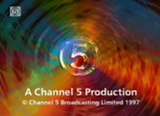 The channel’s programming arrangements are identical to that of Channel 4; most programming is provided by ‘independent’ producers, though some of the production companies that were originally used such as Grundy were owned by Fremantle Media (now Talkback Thames), whose parent company (Bertlesmann/RTL) at the time owned a majority share in Channel 5.
The channel’s programming arrangements are identical to that of Channel 4; most programming is provided by ‘independent’ producers, though some of the production companies that were originally used such as Grundy were owned by Fremantle Media (now Talkback Thames), whose parent company (Bertlesmann/RTL) at the time owned a majority share in Channel 5.
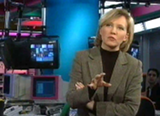 Where Channel 5 really innovated was its news service. As well as the concept of short hourly bulletins which was new at least to terrestrial television in the UK, there were differences in the presentation and content of the main news programme (initially shown at 8:30 pm). Channel 5’s original lineup of news presenters included Kirsty Young (pictured), Rob Butler, Scott Chisholm and Charlie Stayt.
Where Channel 5 really innovated was its news service. As well as the concept of short hourly bulletins which was new at least to terrestrial television in the UK, there were differences in the presentation and content of the main news programme (initially shown at 8:30 pm). Channel 5’s original lineup of news presenters included Kirsty Young (pictured), Rob Butler, Scott Chisholm and Charlie Stayt.
 Originally produced by ITN (who also provide ITV and Channel 4 news programming), Channel 5 News aims to be highly visual yet informative but at the same time less formal in style – for example the presenter does not sit at a desk as is traditional. The end result has won various awards. Kirsty Young later moved to ITV, and Sky took over production of Five News for a while before it reverted back to ITN more recently.
Originally produced by ITN (who also provide ITV and Channel 4 news programming), Channel 5 News aims to be highly visual yet informative but at the same time less formal in style – for example the presenter does not sit at a desk as is traditional. The end result has won various awards. Kirsty Young later moved to ITV, and Sky took over production of Five News for a while before it reverted back to ITN more recently.
 Here is Channel 5’s first Monday evening lineup with wildlife, property, a film and comedy all featuring in the schedule as well as news bulletins every hour. None of the featured programmes are still on-air.
Here is Channel 5’s first Monday evening lineup with wildlife, property, a film and comedy all featuring in the schedule as well as news bulletins every hour. None of the featured programmes are still on-air.
 General purpose tv channels try to feature at least one soap opera in their schedule; the home-grown effort is entitled Family Affairs which finished at the end of 2005, though the channel for a while also showed imported US soaps such as Melrose Place and Sunset Beach which were hitherto only viewable on satellite channels in the UK. Nowadays it is Neighbours that fulfils the channel’s soap opera quotient; something that used to be shown on daytime BBC1 from 1986 to 2008.
General purpose tv channels try to feature at least one soap opera in their schedule; the home-grown effort is entitled Family Affairs which finished at the end of 2005, though the channel for a while also showed imported US soaps such as Melrose Place and Sunset Beach which were hitherto only viewable on satellite channels in the UK. Nowadays it is Neighbours that fulfils the channel’s soap opera quotient; something that used to be shown on daytime BBC1 from 1986 to 2008.
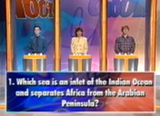 The early evening period (originally 5:30-6:30pm) during Monday to Friday was initially used for now defunct quiz shows such as 100% (pictured) and Whittle; the latter being suspiciously similar in format to a quiz previously tried by ITV and then dropped. 100% featured three contenstants answering 100 multiple choice questions – the person at the end with the highest percentage of correct answers wins £100 and is invited back to appear on the next show. This format was later extended for 100% Gold (for older people) and 100% Challenge (featuring winners from Mastermind), as well as a variety of special one-off programmes devoted to specialist subjects.
The early evening period (originally 5:30-6:30pm) during Monday to Friday was initially used for now defunct quiz shows such as 100% (pictured) and Whittle; the latter being suspiciously similar in format to a quiz previously tried by ITV and then dropped. 100% featured three contenstants answering 100 multiple choice questions – the person at the end with the highest percentage of correct answers wins £100 and is invited back to appear on the next show. This format was later extended for 100% Gold (for older people) and 100% Challenge (featuring winners from Mastermind), as well as a variety of special one-off programmes devoted to specialist subjects.
 Channel 5 often shows programmes featuring animals of some description, whether it is about the work of a wildlife sanctuary (Wildlife SOS, pictured), or wild animals in continents such as Africa.
Channel 5 often shows programmes featuring animals of some description, whether it is about the work of a wildlife sanctuary (Wildlife SOS, pictured), or wild animals in continents such as Africa.
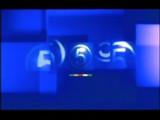 For its first four or so years, Channel 5’s audience share was still small compared with the other four terrestrial channels, but the channel’s majority shareholder (Bertlesmann/RTL) had other plans. Indeed RTL openly declared that they were no longer interested in acquiring any part of ITV and are concentrating their efforts instead on improving Channel 5’s audience figures in the UK which included a major investment in new programming. However Channel 5 still had a decidedly downmarket image that sometimes even included soft porn after the 9 pm watershed, so major moves were required to improve this situation.
For its first four or so years, Channel 5’s audience share was still small compared with the other four terrestrial channels, but the channel’s majority shareholder (Bertlesmann/RTL) had other plans. Indeed RTL openly declared that they were no longer interested in acquiring any part of ITV and are concentrating their efforts instead on improving Channel 5’s audience figures in the UK which included a major investment in new programming. However Channel 5 still had a decidedly downmarket image that sometimes even included soft porn after the 9 pm watershed, so major moves were required to improve this situation.
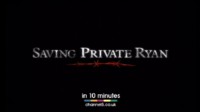 With Dawn Airey as programme controller (she recently defected to BSkyB), some radical moves were made in order to improve Channel 5’s programming along with its reputation. Its one quality import, CSI: Crime Scene Investigation was heavily promoted in quality newspapers, and changes were made to the schedule such as the axing of Night Fever and the acquisition of Home and Away which was originally shown on ITV. The channel even put in a bid for The Simpsons which caught Channel 4 by surprise and helped escalate the bidding war as a result, but better programmes were just one part of its quest for self-improvement.
With Dawn Airey as programme controller (she recently defected to BSkyB), some radical moves were made in order to improve Channel 5’s programming along with its reputation. Its one quality import, CSI: Crime Scene Investigation was heavily promoted in quality newspapers, and changes were made to the schedule such as the axing of Night Fever and the acquisition of Home and Away which was originally shown on ITV. The channel even put in a bid for The Simpsons which caught Channel 4 by surprise and helped escalate the bidding war as a result, but better programmes were just one part of its quest for self-improvement.
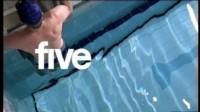 In order to convince more people to start watching the channel on a regular basis, some drastic action was taken. Firstly what was known as Channel 5 is now simply known as Five, with the word being used in lower case as a logo. The rebranding was accompanied by a whole new presentation package which includes a mixture of new live action-based and plain idents with the word ‘five’ often appearing and disappearing with a 3D effect; the ‘five stripes’ device (shown above) also being abandoned in preference to individually using five shades of five colours for text and background colours.
In order to convince more people to start watching the channel on a regular basis, some drastic action was taken. Firstly what was known as Channel 5 is now simply known as Five, with the word being used in lower case as a logo. The rebranding was accompanied by a whole new presentation package which includes a mixture of new live action-based and plain idents with the word ‘five’ often appearing and disappearing with a 3D effect; the ‘five stripes’ device (shown above) also being abandoned in preference to individually using five shades of five colours for text and background colours.
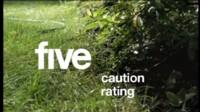 But it didn’t stop there – Five scrapped the contentious permanent on-screen logo for the time being so it would be identified more closely with the other four terrestrial channels. Five’s presentation package was developed by the same agency (Spin) that worked on the previous Channel 4 idents, hence some general similarities between the two channels’ overall presentation until Channel 4 changed its on-air identity on 31 December 2004. The channel was at this point 100% owned by RTL, the Bertlesmann-owned company that operates various other European TV channels, after UBM (United Business Media) sold its stake in July 2005, but that state of affairs wasn’t to last forever.
But it didn’t stop there – Five scrapped the contentious permanent on-screen logo for the time being so it would be identified more closely with the other four terrestrial channels. Five’s presentation package was developed by the same agency (Spin) that worked on the previous Channel 4 idents, hence some general similarities between the two channels’ overall presentation until Channel 4 changed its on-air identity on 31 December 2004. The channel was at this point 100% owned by RTL, the Bertlesmann-owned company that operates various other European TV channels, after UBM (United Business Media) sold its stake in July 2005, but that state of affairs wasn’t to last forever.
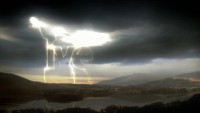

Not too long after RTL gained control of the channel, Five gained a new identity package in 2006 comprising of outdoor-themed idents that featured four-letter words such as ‘live’ ‘rush’, ‘free’, etc., being visually formed using objects (such as lightning from a cloud or flying balloons); after Christmas 2006 the individual words were replaced with the channel name ‘five’ as can be seen from the above balloons example. Spin-off channels Five Life and Five US were also launched in the same year; Five having previously leased its two Freeview channels to Top Up TV in 2003.
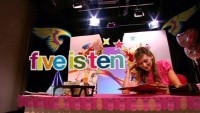 March 30 2007 was Channel Five’s tenth anniversary, and the channel celebrated with an evening of special programmes featuring (amongst other things) a group of ten year-olds interviewing the potential future prime minister Gordon Brown, ‘reality TV’ offering The Ten Demandments, and a light-hearted quiz entitled Blame it on the Spice Girls. Quite. Also Channel Five acquired the rights to show the Australian soap opera Neighbours, of which it started to show from 2008 when the BBC’s contract expired.
March 30 2007 was Channel Five’s tenth anniversary, and the channel celebrated with an evening of special programmes featuring (amongst other things) a group of ten year-olds interviewing the potential future prime minister Gordon Brown, ‘reality TV’ offering The Ten Demandments, and a light-hearted quiz entitled Blame it on the Spice Girls. Quite. Also Channel Five acquired the rights to show the Australian soap opera Neighbours, of which it started to show from 2008 when the BBC’s contract expired.
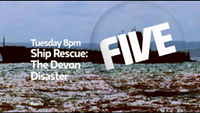 It wasn’t long (October 2008) before Channel Five had yet another image makeover, with a change of font for the FIVE logo which now appeared in capitals within a circle and yet more idents as a consequence. Earlier that same year, Dawn Airey had been rehired from ITV and promptly went on a cost-cutting spree at the channel. Programmes shown during this era included Paul Merton in India, Grey’s Anatomy, Police Interceptors and the return of quiz Going for Gold along with the CSI franchise acquired via a pan-European deal with parent company RTL.
It wasn’t long (October 2008) before Channel Five had yet another image makeover, with a change of font for the FIVE logo which now appeared in capitals within a circle and yet more idents as a consequence. Earlier that same year, Dawn Airey had been rehired from ITV and promptly went on a cost-cutting spree at the channel. Programmes shown during this era included Paul Merton in India, Grey’s Anatomy, Police Interceptors and the return of quiz Going for Gold along with the CSI franchise acquired via a pan-European deal with parent company RTL.
 Despite all the hard work, it just wasn’t enough. Five’s German owner RTL was rapidly running out of patience with what it had dubbed “the English patient” in its European channel portfolio, having written off a large debt in 2009 and made a decision to only concentrate on owning broadcasters and channels that were either first or second in terms of popularity in their native countries, meaning that it was now actively willing to sell off Five to another company. BSkyB had long been suspected of being a potential buyer of Five, but it had primarily concentrated on pay-TV broadcasting via satellite with its free-to-air channels on Freeview being an ‘accidental’ sideshow perhaps to avoid its desirable channel slots falling into the hands of competitors, therefore the eventual buyer of Five turned out to be Richard Desmond and his media empire which includes the Express and Star newspapers. The company changed hands on 23 July 2010 for £103.5m.
Despite all the hard work, it just wasn’t enough. Five’s German owner RTL was rapidly running out of patience with what it had dubbed “the English patient” in its European channel portfolio, having written off a large debt in 2009 and made a decision to only concentrate on owning broadcasters and channels that were either first or second in terms of popularity in their native countries, meaning that it was now actively willing to sell off Five to another company. BSkyB had long been suspected of being a potential buyer of Five, but it had primarily concentrated on pay-TV broadcasting via satellite with its free-to-air channels on Freeview being an ‘accidental’ sideshow perhaps to avoid its desirable channel slots falling into the hands of competitors, therefore the eventual buyer of Five turned out to be Richard Desmond and his media empire which includes the Express and Star newspapers. The company changed hands on 23 July 2010 for £103.5m.
 From Five to 5…Another thing on Richard Desmond’s to-do list was changing the name back to Channel 5 because he felt that the original brand resonated more strongly with the public, and he wasted no time in doing such a thing, therefore new idents, etc., were commissioned to go with the new name.
From Five to 5…Another thing on Richard Desmond’s to-do list was changing the name back to Channel 5 because he felt that the original brand resonated more strongly with the public, and he wasted no time in doing such a thing, therefore new idents, etc., were commissioned to go with the new name.
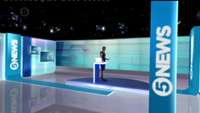 With the new identity came a new look for 5 News, which still maintained the “standing up” ethos that Channel 5 had made its own from the beginning.
With the new identity came a new look for 5 News, which still maintained the “standing up” ethos that Channel 5 had made its own from the beginning.
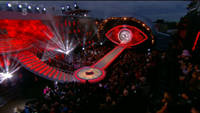 Perfect match…Upon acquiring Five, Richard Desmond made several bold and somewhat rash claims relating to what he wanted to do with the broadcaster that were probably not meant to be taken seriously, such as acquiring EastEnders of all things (!!!), but he did say he wanted to make a big programming acquisition from another channel. That turned out to be Big Brother: a reality TV series which had gone into decline when shown on Channel 4 as well as being perceived to have tarnished Channel 4’s reputation as a broadcaster, therefore Desmond was able to acquire the rights to Big Brother when they came up for renewal. Big Brother, Celebrity Big Brother and their various spin-off programmes have been solid performers for Channel 5, which proved how good the fit between programme format and broadcaster turned out to be.
Perfect match…Upon acquiring Five, Richard Desmond made several bold and somewhat rash claims relating to what he wanted to do with the broadcaster that were probably not meant to be taken seriously, such as acquiring EastEnders of all things (!!!), but he did say he wanted to make a big programming acquisition from another channel. That turned out to be Big Brother: a reality TV series which had gone into decline when shown on Channel 4 as well as being perceived to have tarnished Channel 4’s reputation as a broadcaster, therefore Desmond was able to acquire the rights to Big Brother when they came up for renewal. Big Brother, Celebrity Big Brother and their various spin-off programmes have been solid performers for Channel 5, which proved how good the fit between programme format and broadcaster turned out to be.
